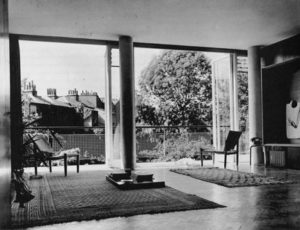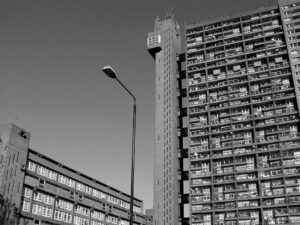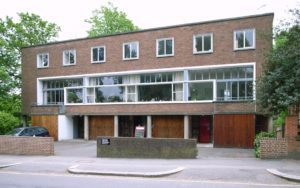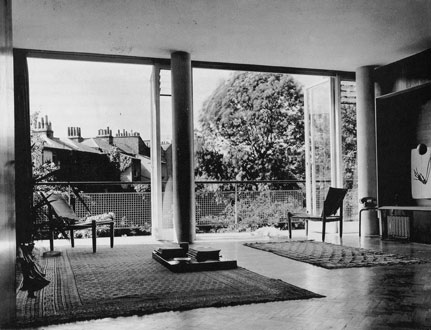By Philip Carter
As a survey of domestic experience, the IHR’s 2018 Winter Conference—‘Home: new histories of living’ (8-9 February)—ranges widely in its locations and forms of historical dwellings. At the same time, individual properties stand out. These include No. 2 Willow Road, Hampstead, now one of London’s best-known modernist houses, which makes two appearances at the Conference and its follow-on events.

Interior, 2 Willow Road, Hampstead
Goldfinger in Hampstead
The work of the Budapest-born architect Ernő Goldfinger (1902-1987), Willow Road was from the outset a controversial design. Goldfinger’s critics—mindful of his training with Le Corbusier—feared the imposition of an angular concrete block in a part of London celebrated more for its fine Georgian architecture and, with the Heath, proximity to largely untamed countryside.
Goldfinger had initially sought to erect a modernist block of flats on the site, but reverted to three residential properties when permission for his larger scheme was refused. Leading critics of his revised project included the conservationist and future MP for Hampstead, Henry Brooke; and the author Ian Fleming whose opposition to Ernö’s architectural tastes resulted, it’s said, in his use of ‘Goldfinger’ as the name for one of 007’s most megalomaniacal villains.
In response, the architect justified his design for Willow Road in terms of its dominant use of brick, relative unobtrusiveness, and a profile no more angular than the much-loved surrounding terraces. In championing modernism Goldfinger was also supported by Hampstead’s avant-garde for whom structures such as Wells Coates’ Isokon Building demonstrated the potential of new residential forms.
Completed in 1939, Nos 1-3 Willow Road are now as much a feature of Hampstead domestic architecture as the neighbouring Georgian cottages. No. 2 Willow Road, the largest of the three properties, was taken by Goldfinger and remained a family home until the architect’s death there in September 1987. Acquired by the National Trust in 1993, the house been open for public viewings since 1996.
Though relatively modest in scale, Nos. 1-3 Willow Road established Goldfinger’s reputation as a coming, and controversial, architect. Denied the opportunity to build at scale and in concrete in pre-war Hampstead, Goldfinger’s Corbusian training was evident in his later expeditions in Brutalism—Balfron Tower, in Poplar, and Trellick Tower in Kensal Town. Today both towers and Nos. 1-3 Willow Road are Grade II* listed.

Trellick Tower
Willow Road and the IHR Winter Conference
Willow Road’s first appearance at the IHR’s Winter Conference comes on Thursday 8 February in the first of two ‘brown bag’ lunchtime slots. Thursday’s session sees short talks from three curators and archivists who’ll each tell the ‘biography’ or life story of a notable domestic object drawn from his or her collection.
From 2 Willow Road, the house steward Leigh Sneade will bring and speak about an artefact in Goldfinger’s collection, in part to highlight broader themes of mid-century modernism. Leigh will also introduce us to the interior spaces in which Ernö and Ursula Goldfinger lived and entertained, and which also became home to a significant art collection by the likes of Barbara Hepworth, Henry Moore, Max Ernst and Marcel Duchamp.

1-3 Willow Road, Hampstead
Our second Goldfinger event of the Winter Conference takes place on Saturday 10 March, and gives delegates the chance to explore 2 Willow Road in greater detail. This takes the form of a guided tour of the house, provided by its National Trust curators, and coming soon after the Willow Road’s reopening following renovation work for the 2018 season. Further details of how to enroll for the 10 March house tour will be made available at the Winter Conference in early February, and then on the IHR website.
For more information on the conference—including details on registration, bursaries for Early Career Researchers, and other extra curriculum activities—please visit the IHR Winter Conference blog.

